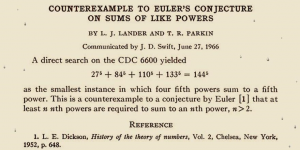
When I come across the number 33 I remember my grandmother Rosario who, every time she heard that number, associated it with “la jota de Ollauri”. Apparently, there was a time when some people from Ollauri used to sing a jota (see in Wikipedia), one of whose verses said “33, 33, 33, 33,…” (note the care I have tried to take to avoid offending the inhabitants of this small Riojan municipality renowned for its wine cellars, which produce wine in a kilometre of caves dug between the 15th and 18th centuries). In 1966, perhaps while my grandmother was singing me that jota to try to put me to sleep, Leon J. Lander and Thomas R. Parkin found, with the help of a CDC 6600 computer, that
$$
27^5 + 84^5 + 110^5 + 133^5 = 144^5.
$$
What is the relevance of this?
Euler had proved in 1740 that the equation \(x^3 + y^3 = z^3\) had no non-zero integer solutions.
Perhaps encouraged by that success, in 1769 he conjectured that, if for some integer exponent \(n \ge 2\) and a number of summands \(k \ge 2\), it was satisfied that
$$
a_1^n + a_2^n + \cdots + a_k^n = c^n
$$
with \(a_1,a_2,\dots,a_k\) and \(c\) positive integers, it must necessarily be \(k \ge n\).
That is, when \(n \ge 2\), at least \(n\) powers \(n\)-th powers are needed to obtain a sum that is also a \(n\)-th power. What Lander and Parkin had found was a counterexample to Euler’s conjecture for \(n=5\). With it they published what is possibly the shortest mathematical research paper in history [4], which we show below:

At the time, Lander and Parkin’s counterexample required considerable computational effort. A few months ago it occurred to me to wonder how much it would cost now to find that counterexample by searching by brute force, that is, trying little by little with all the numbers until I saw it appear. Today’s computer is much more powerful than then, so I thought I’d do it with my mobile phone, which is not particularly new. I wrote a little program in Lua (an interpreted programming language, slower than a compiled one) and tried it: 8 seconds were enough.
Finding a counterexample to Euler’s conjecture for \(n=4\) was more complicated.
Could it be true that there were no positive integers \(x\), \(y\), \(z\) and \(t\) such that \(x^4 + y^4 + z^4 = t^4\)?
The answer remained elusive until 1987, when Noam Elkies proved –using elliptic curves and computational help– that the conjecture was false in this case too: he found the solution
$$
2\,682\,440^4 + 15\,365\,639^4 + 18\,796\,760^4 = 20\,615\,673^4
$$
and even proved that there was an infinite class of solutions. The following year, Roger Frye found
$$
95\,800^4 + 217\,519^4 + 414\,560^4 = 422\,481^4
$$
and proved that this was the smallest possible solution. It is worth noting that it is not yet known what happens with powers six or higher.
And what does this have to do with the number \(33\) that we mentioned at the beginning?
Equations for which integer solutions are sought are called diophantine equations. The reason for this name is that, in the third century, Diophantus of Alexandria was engaged in describing methods of solving many such equations (see [2]); he was actually looking for rational and positive solutions, but nowadays the term “diophantine” is applied primarily when the required solutions are integers. It was in the margin of a copy of Diophantus’ book that Fermat wrote his oft-repeated statement about the absence of integer (and non-trivial) solutions of the equation \(x^n + y^n = z^n\) for \(n \ge 3\). The tenth of the 23 problems proposed by David Hilbert in his famous lecture The Future Problems of Mathematics at the International Congress of Mathematicians in Paris in 1900, which has had such an influence on the development of twentieth-century mathematics, dealt with diophantine equations. With a display of optimism, Hilbert asked whether there was a universal algorithm for solving these equations. It was in 1970 that the young Russian mathematician Yuri Matiyasevich proved that such a method applicable to solving any diophantine equation could not exist. I must confess that I am fascinated by these equations, but I usually have to watch them from afar.
It turns out that the number \(33\) has been the recent protagonist of a simple diophantine equation for which, until now, no solution was known. At the suggestion of the mathematician Louis J. Mordell, in 1955 [5], J. C. P. Miller and M. F. C. Woollett programmed the EDSAC computer at Cambridge University to search for integer solutions to the equation
$$
k = x^3 + y^3 + x^3
$$
with \(k\) a prefixed non-zero integer (see [5]), which must be \(k \not\equiv \pm4 \pmod{9}\) for solutions to exist (since \(t^3 \equiv 0\), \(1\) or \(-1 \pmod{9}\), at least four cubes are needed for their sum to have the form \(9m\pm4\)). In fact, in 1992, perhaps at the same time as the Pavilion of Discoveries was burning in Seville, D. R. Heath-Brown [3] conjectured, on the basis of heuristic arguments, that such an equation must have infinitely many integer solutions for any admissible \(k\). Until recently, solutions were known for all \(k < 1000\) except for the numbers \(33\), \(42\), \(114\), \(165\), \(390\), \(579\), \(627\), \(633\), \(732\), \(795\), \(906\), \(921\) and \(975\). To find such solutions, the help of powerful computers and the use of Elkies’ algorithm –the mathematician mentioned above– is essential, as well as some ideas that have allowed us to do it faster.
In March 2019, Andrew R. Booker has found the first solution of this equation with \(k=33\), which is
$$
33 = 8\,866\,128\,975\,287\,528^3 + (-8\,778\,405\,442\,862\,239)^3 + (-2\,736\,111\,468\,807\,040)^3.
$$

Of course, this solution is not easy to find, so, instead of publishing a short article like Lander and Parkin’s, its discoverer has given us the details of the process he followed to find it thanks to a massively parallel supercomputer at the University of Bristol; they can be seen in [1]. In this type of research it is not only important to have specialised algorithms and powerful computers, but also to optimise the speed of execution of these algorithms, so Booker has used C language with some assembler routines (the truth is that this writer does not understand why many universities do not explain C as the first programming language to mathematics students, instead of other languages that are undoubtedly worse in terms of performance). Booker has also looked for a solution for \(k=42\), but so far without success.
References
[1] A. R. Booker, Cracking the problem with \(33\),
prepublicación disponible en https://arxiv.org/abs/1903.04284
[2] Diofanto de Alejandría, La Aritmética y el libro Sobre los números poligonales,
2 vols., Nivola (Colección Epistéme 6 y 7), Tres Cantos (Madrid), 2008.
Spanish version, introduction, notes and appendices by
M. Benito, E. Fernández y M. Sánchez.
[3] D. R. Heath-Brown, The density of zeros of forms for which weak approximation fails,
Math. Comp. 59 (1992), 613-623.
[4] L. J. Lander y T. R. Parkin,
Counterexample to Euler’s conjecture on sums of like powers,
Bull. Amer. Math. Soc. 72 (1966), 1079.
[5] J. C. P. Miller y M. F. C. Woollett,
Solutions of the Diophantine equation \(x^3 +y^3 +z^3 = k\),
J. London Math. Soc. 30 (1955), 101-110.

Leave a Reply